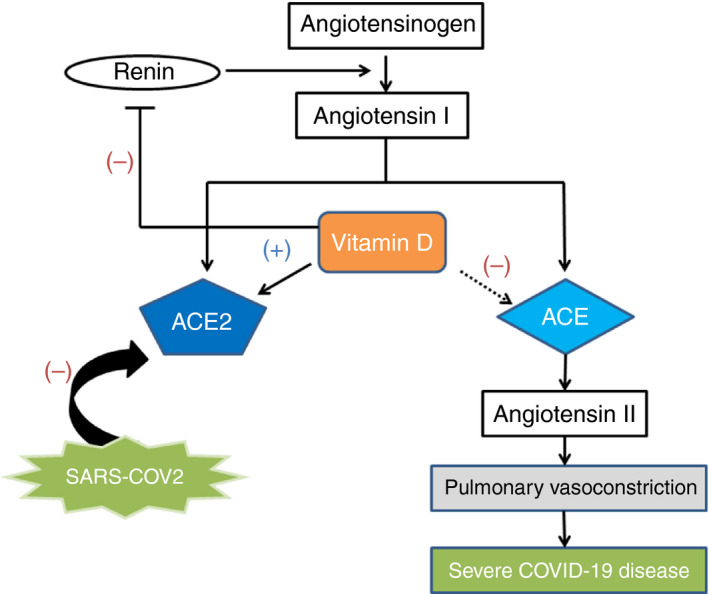Short abstract
LINKED CONTENT
This article is linked to Tian et al and Tian and Rong papers. To view these articles, visit https://doi.org/10.1111/apt.15731 and https://doi.org/10.1111/apt.15817.
We read with interest the article by Tian et al reviewing the gastrointestinal aspects of COVID‐19 and the letter published in connection with that by Panarese and Shahini. 1 , 2 The latter recommended vitamin D prophylaxis for prevention of COVID‐19 particularly in cases of vitamin D deficiency.
In this context, several authorities believe that vitamin D will be beneficial, and clinical trials are currently underway. 3 There is a paucity of data to show the role of vitamin D on COVID‐19. It is also vital to know the role of vitamin D on asymptomatic COVID‐19 cases. The positive role of vitamin D in diabetes mellitus, and cardiovascular disease may be beneficial in controlling COVID‐19. 4
However, there is a paradoxical effect of vitamin D for preventing the severity of COVID‐19. Since the world is currently facing a pandemic, discussion of this is also essential. When inhaled, the SARS‐CoV‐2 virus, attaches to angiotensin‐converting enzyme 2 (ACE2) expressed on the surface of alveolar epithelial cells. Once the virus binds to ACE2, it reduces its activity and, in turn, promotes ACE1 activity forming more angiotensin II. It causes heightened pulmonary vasoconstriction and severity of COVID‐19. 5 , 6
The vitamin D analogue calcitrol increases expression of ACE2 in the lungs in experimental animals in specific experimental conditions. 7 ACE2 thus expressed more as a consequence of vitamin D supplementation might reduce lung injury. 8 It can promote binding of the virus to the pulmonary epithelium. Also, vitamin D may suppress renin activity. 7 That in turn may generate less angiotensin II resulting in less pulmonary vasoconstriction (Figure 1). Although vitamin D induces the expression of ACE2, which indeed promotes the binding of the virus, it prevents pulmonary vasoconstriction response in COVID‐19 cases. COVID‐19 is not an isolated disease where vitamin D behaves in this manner. A similar mechanism is observed in influenza. The influenza virus H7N9 also produces a heightened angiotensin II response, and lung injury is prevented by the expression of ACE2 protein. 9 However, vitamin D supplementation prevents influenza‐related illness. 10 Although the exact mechanism remains unclear, ACE2 over‐expression could be a possibility. Based on the above observation, we conclude that vitamin D may reduce the severity of COVID‐19 in a manner analogous to influenza.
FIGURE 1.

The role of vitamin D in COVID‐19. SARS‐CoV‐2 binds to the ACE2 of alveolar cells and disturbs the ratio of ACE2/ACE activity. It increases ACE activity and, in turn, results in more angiotensin II formation causing pulmonary vasoconstriction to precipitate severe COVID19. Vitamin D induces ACE2 expression, which limits the formation of angiotensin II via ACE and reduces lung injury. Besides, vitamin D also acts on renin and inhibits its activity, which further contributes to the reduction in angiotensin II. Therefore, vitamin D supplementation may have a protective role against COVID‐19. (Dotted line indicates indirect effect)
AUTHORSHIP
Guarantor of the article: Dibyajyoti Banerjee.
Author contributions: All the authors developed the concept, contributed to writing the manuscript and approved the final version of the manuscript.
ACKNOWLEDGEMENT
Declaration of personal interests: None.
REFERENCES
- 1. Tian Y, Rong L, Nian W, He Y. Review article: gastrointestinal features in COVID‐19 and the possibility of faecal transmission. Aliment Pharmacol Ther. 2020;51:843‐851. [DOI] [PMC free article] [PubMed] [Google Scholar]
- 2. Panarese A, Shahini E. Letter: covid‐19, and vitamin D. Aliment Pharmacol Ther. 2020;51:993‐995. [DOI] [PMC free article] [PubMed] [Google Scholar]
- 3. Vitamin D on prevention and treatment of covid‐19 ‐ full text view ‐ clinicaltrials. Gov [Internet]. https://clinicaltrials.gov/ct2/show/NCT04334005. Accessed April 21, 2020.
- 4. Wang H, Chen W, Li D, et al. Vitamin D and chronic diseases. Aging Dis. 2017;8:346‐353. [DOI] [PMC free article] [PubMed] [Google Scholar]
- 5. Rolf JD. Clinical characteristics of covid‐19 in china. N Engl J Med. 2020;382:1860. [DOI] [PubMed] [Google Scholar]
- 6. Covid‐19 infection and renin angiotensin system blockers [Internet]. American College of Cardiology. https://www.acc.org/latest‐in‐cardiology/ten‐points‐to‐remember/2020/04/07/12/25/coronavirus‐disease‐2019‐infection‐and‐ras. Accessed April 23, 2020. [Google Scholar]
- 7. Xu J, Yang J, Chen J, Luo Q, Zhang Q, Zhang H. Vitamin D alleviates lipopolysaccharide‐induced acute lung injury via regulation of the renin‐angiotensin system. Mol Med Rep. 2017;16:7432‐7438. [DOI] [PMC free article] [PubMed] [Google Scholar]
- 8. Imai Y, Kuba K, Rao S, et al. Angiotensin‐converting enzyme 2 protects from severe acute lung failure. Nature. 2005;436:112‐116. [DOI] [PMC free article] [PubMed] [Google Scholar]
- 9. Yang P, Gu H, Zhao Z, et al. Angiotensin‐converting enzyme 2 (ACE2) mediates influenza H7N9 virus‐induced acute lung injury. Sci Rep. 2014;13:7027. [DOI] [PMC free article] [PubMed] [Google Scholar]
- 10. Gruber‐Bzura BM. Vitamin D and influenza—prevention or therapy? Int J Mol Sci. 2018;19:2419. [DOI] [PMC free article] [PubMed] [Google Scholar]


